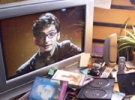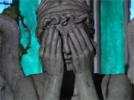Blink
Steven Moffat is an evil man. He wants to frighten children. Gas masks. Clown faces. Statues that move when you’re not watching. If I were ten, I would be seriously terrified by his episodes.1 I’m an adult though, and I just love them instead. Mostly, I love them for that feeling you get when you’re watching any of his shows — even an episode of Coupling — and you start notice one of his clever plot elements at work and start to wonder how it’s all going to fit together.
‘Blink’ is also the second of the ‘Doctor-lite’ stories; the episodes that get filmed near the end of the season, back to back with the final two-parter, without much access to the stars of the show. And just like ‘Love & Monsters’, it’s a story that never feels like it’s missing them.2 It’s quite different, though — the major theme of that story seemed to be the effect that the Doctor has on the people who’s lives he touches; ‘Blink’ is much more concerned, like ‘The Girl in the Fireplace’, with the difference between the Doctor’s life and that of a normal human — the tragedy and joy of being stuck on the slow path.
‘Blink’ is the story of Sally Sparrow. It’s also the story of a bunch of angelic, deadly statues. It’s barely worth going into any more detail than that — the story offers more than its fair share of little twists along the way, and I’m reluctant to give any of them away.3
The story is packed with the sort of clever, time-travel related plot elements that you’d expect to see more of in Doctor Who but don’t. The Doctor’s easter egg legacy is especially amusing. The idea behind the monsters is particularly clever — interviewed, Moffat said that you haven’t written a really good Who script until you’ve thought “Well, there goes another good idea for a feature film,” and these creepy, elegant creatures would certainly be a good start.4
The other standout in the episode is Sally Sparrow, as played by Carey Mulligan. Funny, hot, sad and awesome. If you thought she was cute in Bleak House, you ain’t seen nothing yet. Her character leads the episode, essentially, and she holds that mantle wonderfully. If I didn’t like Martha so much, I’d say she should be the companion. Why not both? It’s a good idea, isn’t it Davies? Bring an old quasi-companion back to join Martha and the Doctor in the TARDIS.5
Three seasons of Doctor Who. Three awesome stories from Steven Moffat. It’s becoming a reassuring constant of the show.
- Mind you, I was frightened by the dodgy plastic mask in ‘The Talons of Weng Chiang’. Which I can’t find a photo of to link to. Just take my word for it, it’s dodgy. ↩
- It’s also the second adaptation of a written-word Who story ever. ↩
- Also, I tried summarising the plot and found it too fiddly. So I then decided to take a principled stance against it. ↩
- There’s been some criticism of them though. I’ll get a bit more detailed here — the angels can’t move when they’re being watched, yet on numerous occasions they don’t in fact seem to be being observed, and continue to be stationary. Some have bagged this, but I particularly like the idea that the audience is still watching them at these points, and so they’re still pinned to the spot. Someone else came up with this and I can’t for the life of me remember who or where. If I remember, this sentence will most likely cease to exist. And the one before it. And this one, too. Jeez, these footnotes are all over the place today. I’m out of practice. ↩
- No! Not that quasi-companion. Oh my giddy aunt. ↩


